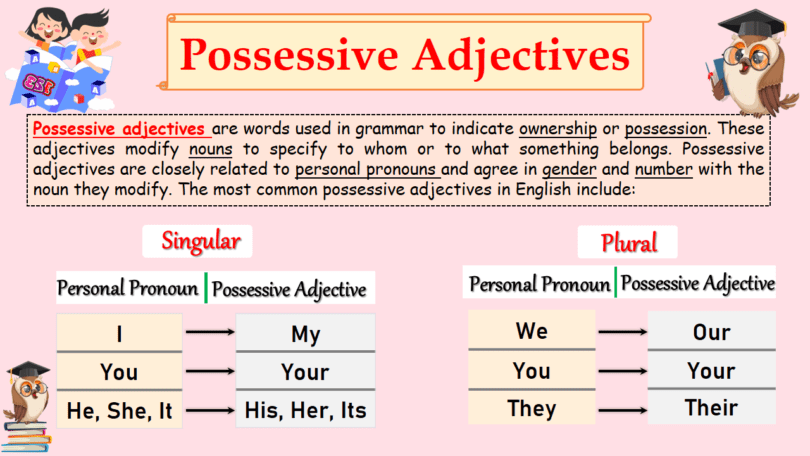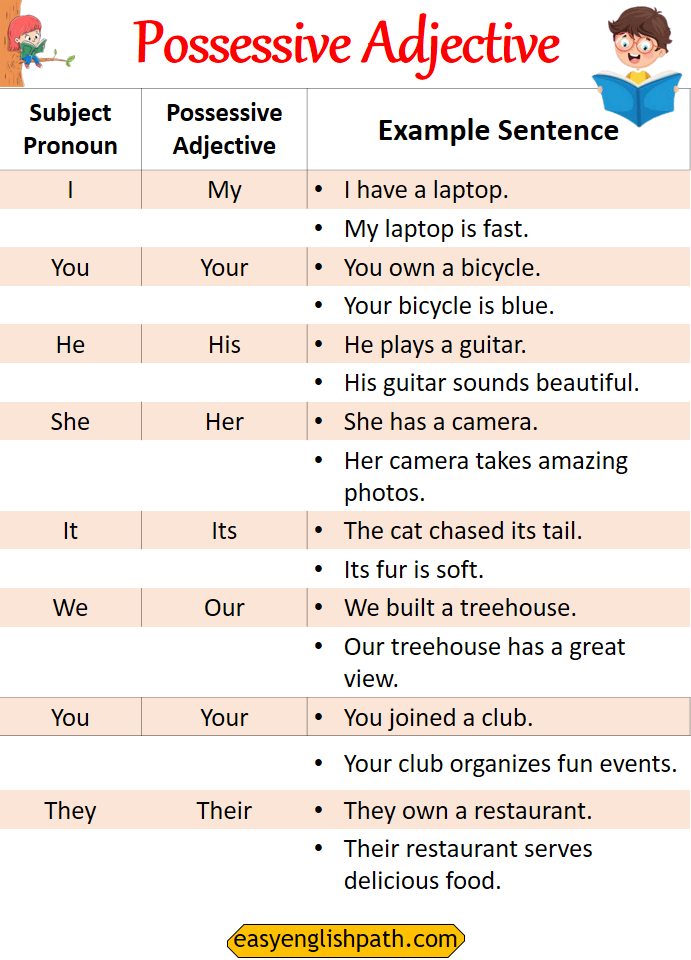Possessive adjectives like ‘my, your, and his show ownership. They make sentences clearer and more interesting. This blog explains what possessive adjectives are, why they are important, and provides examples. It’s simple and easy to understand, perfect for students learning English or anyone wanting to learn more about these words.
What is a Possessive Adjective?
A possessive adjective is a word that tells us who something belongs to. It always comes before a thing or a person to show ownership.
Example Words:
- my, your, his, her, their, its, our, whose
Example Sentences
- This is my ball.
- Her house is larger than your house.
- Will you be going to his birthday party?
- Have you seen our new website?
Subject Pronouns and their Possessive Adjectives:
| Subject Pronoun | Possessive Adjective |
| I | my |
| You (singular) | your |
| He | his |
| She | her |
| It | its |
| We | our |
| You (plural) | your |
| They | their |
Subject pronouns are pronouns that take the place of the subject in a sentence. They indicate who or what is performing the action of the verb.
Possessive Pronouns and their Possessive Adjectives:
| Possessive Pronoun | Possessive Adjective |
|---|---|
| Mine | My |
| Yours | Your |
| His | His |
| Hers | Her |
| Its | Its |
| Ours | Our |
| Yours (plural) | Your (plural) |
| Theirs | Their |
Types of Possessive Adjectives
Possessive adjectives are used to indicate ownership or possession. They change based on the person (first, second, or third) and the number (singular or plural).
1. First Person Possessive Adjectives
First-person possessive adjectives refer to the speaker or writer.
Singular: Used when the speaker is referring to something that belongs to them.
- My book is on the table.
- My dog loves to play.
Plural: Used when the speaker is referring to something that belongs to a group that includes them.
- Our team won the match.
- Our teacher gave us homework.
2. Second Person Possessive Adjectives
Second-person possessive adjectives refer to the person or people being spoken to.
Singular: Used when addressing one person.
- Your homework is due tomorrow.
- Your idea was brilliant.
Plural: Used when addressing more than one person.
- Your seats are in the front row.
- Your plans sound exciting.
3. Third Person Possessive Adjectives
Third-person possessive adjectives refer to someone or something that is neither the speaker nor the listener.
Singular: Refers to one individual or object.
- His car is parked outside.
- Her dress is beautiful.
- Its tail is fluffy. (Used for animals or objects)
Plural: Refers to multiple individuals or objects.
- Their house is big.
- Their exams start next week.
Key Difference from Personal Pronouns
- Possessive adjectives (my, your, his, her, its, our, their) modify a noun (my book, your car).
- Personal pronouns (I, you, he, she, it, we, they) replace a noun (This is my book → This is mine).
Rules of Possessive Adjectives
1. Showing Ownership – Used to show that something belongs to someone.
- My book is on the table.
- Our dog is very smart.
2. Describing Relationships – Indicate relationships between people or things.
- Her brother is very kind.
- Its tail is red.
3. Indicating Parts of Something – Specify parts of a whole.
- He broke his leg.
- She hurt her arm.
4. Clarifying Ambiguity – Make it clear who or what is being referred to.
- Their car is parked outside.
- Their house is for sale.
Possessive Adjectives and Possessive Pronouns:
| Feature | Possessive Adjectives | Possessive Pronouns |
|---|---|---|
| Function | Modify a noun to show ownership | Replace a noun to show ownership |
| Usage | Must be followed by a noun | Stands alone without a noun |
| Examples | My book, your car, his phone | The book is mine, The car is yours |
| Words Used | My, Your, His, Her, Its, Our, Their | Mine, Yours, His, Hers, Its, Ours, Theirs |
| Example Sentences | This is my bag. | This bag is mine. |
Possessive Adjectives Examples
- My cat enjoys sleeping on the windowsill.
- His car is parked in the driveway.
- Our favorite restaurant is closed on Sundays.
- Her laptop is on the kitchen table.
- Their children go to the same school.
- Your jacket is hanging in the closet.
- Its fur is soft and fluffy.
- Our friends are coming over for dinner tonight.
- Your keys are on the counter.
- Their house has a beautiful garden.
Common Mistakes with Possessive Adjectives
1. Confusing “its” and “it’s”
❌ The cat lost it’s toy.
✅ The cat lost its toy.
(“Its” shows possession, while “it’s” means it is.)
2. Using a subject pronoun instead of a possessive adjective
❌ Me book is on the table.
✅ My book is on the table.
(“Me” is incorrect; use “My” to show possession.)
3. Mixing up “their,” “there,” and “they’re”
❌ There car is very fast.
✅ Their car is very fast.
(“Their” is the possessive adjective; “there” refers to a place, and “they’re” means they are.)
4. Using “his” or “her” incorrectly for neutral objects
❌ The company lost his reputation.
✅ The company lost its reputation.
(“His” is for people, while “its” is for things like companies, animals, or objects.)
5. Forgetting to match the possessive adjective with the correct noun
❌ She borrowed their pen. (when referring to one person)
✅ She borrowed her pen.
(Use “her” if the pen belongs to one female, and “their” for multiple owners.)
FAQs on Possessive Adjectives
1. Do possessive adjectives change based on singular or plural nouns?
No, possessive adjectives remain the same regardless of whether the noun is singular or plural (my book / my books).
2. What are possessive adjectives?
Possessive adjectives are words that show ownership or possession, such as my, your, his, her, its, our, and their. They modify a noun (e.g., my book, their house).
3. How are possessive adjectives different from possessive pronouns?
Possessive adjectives modify a noun (This is my car), while possessive pronouns replace a noun (This car is mine).
4. Can “its” be used for people?
No, its is used for animals or objects, not people. For people, use his, her, or their.
You May Also Like






